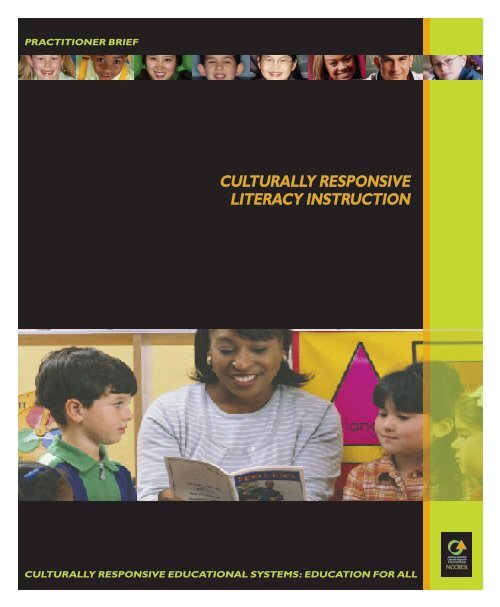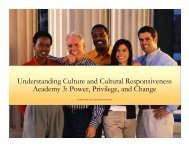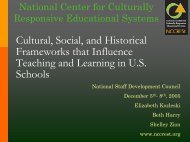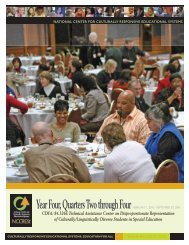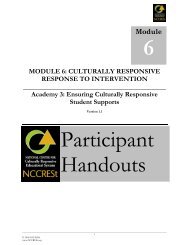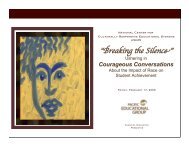CULTURALLY RESPONSIVE LITERACY INSTRUCTION - NCCRESt
CULTURALLY RESPONSIVE LITERACY INSTRUCTION - NCCRESt
CULTURALLY RESPONSIVE LITERACY INSTRUCTION - NCCRESt
Create successful ePaper yourself
Turn your PDF publications into a flip-book with our unique Google optimized e-Paper software.
practitioner briefCulturally ResponsiveLiteracy InstructionCulturally Responsive Educational Systems: Education for All
2The missionof the NationalCenter forCulturally ResponsiveEducational Systems(nccrest) is to supportstate and localschool systemsto assure aquality, culturallyresponsive educationfor all students.
will want to give an equal emphasis to reading andwriting and to look at ways that instruction of one canstrengthen the learning of the other. Teachers shouldencourage students of diverse backgrounds to usestrengths in their home languages as the basis forbecoming proficient in reading and writing in English.COnstructInG MeAnING Third, readingand writing are used to construct meaning throughinteractions among the reader, the text, and the socialtext. This view of reading and writing reminds us of theimportance of the background knowledge that studentsbring to the task. A reader’s background knowledgestrongly influences variations of interpretations oftext due to differences in the prior knowledge orcultural schemata students bring to the reading task.Printed text Fourth, the definition of literacydescribed here refers to the student’s ability towork with the printed text, which distinguishes itfrom “cultural literacy” or “computer literacy.” Theteacher’s reading aloud of literature and collaborativewriting provide opportunities for literacy learning.Social context Finally, the social contexts ofthe home and community often prepare students ofdiverse backgrounds to learn in ways quite differentfrom those expected by the school. Students ofdiverse backgrounds often experience literacy in socialcontexts vastly different from those typically foundin schools. The teacher’s goal is to enable students ofdiverse backgrounds to use literacy successfully inmainstream social contexts, as well as in the contextsof their homes and communities by modifying thesocial context of instruction so that lessons can bemore effective for students of diverse backgrounds.Importance of EarlyReading SuccessSignificant societal gains can come from earlyreading success. For example, the National ReadingPanel (2000) cites information published by theNational Right to Read Foundation outlining thesocietal costs of illiteracy:• 85% of delinquent children and 75% of adultprison inmates are illiterate.• 90 million adults in the United States are atbest functionally literate.• The cost to taxpayers of adult illiteracy is $224billion a year in welfare payments, crime, jobincompetence, lost taxes, and remedial education.• U.S. companies lose nearly $40 billion annuallybecause of illiteracy.The “chicken-egg” logic here is that if you teach achild to read he or she will be less of a strain onsociety because he or she will be less likely to be onwelfare, commit a crime, skip work, fail to pay taxes,and need remedial education (Willis & Harris, 2000).Culturally and linguistically diverse students are thetargeted population for improved literacy instructionbecause they continue to be overrepresented inspecial education programs. Of the six millionchildren in special education, half of those who arein special education are identified as having aspecific learning disability. In fact, this group hasgrown more than 300% since 1976. Of those with5
ReferencesAu, K. H. (1993). Literacy instruction inmulticultural settings. Fort Worth, TX: HarcourtBrace Jovanovich College Publishers.Au, K. H., Mason, J. M., & Scheu, J. A. (1995).Literacy instruction today. New York, NY: HarperCollins College Publishers.Beaulieu, L. M. (2002). African American childrenand literacy: Literacy development across theelementary, middle, and high school years. InS. J. Denbo & L. M. Beaulieu (Eds.), Improvingschools for African American students (pp. 133-145). Springfield, IL: Charles C. Thomas.Block, C. C., Oakar, M., & Hurt, N. (2002). Theexpertise of literacy teachers: A continuumfrom preschool to grade 5. Reading ResearchQuarterly, 37(2), 178-206.Brown University. (2003). The knowledge loom:What works in teaching and learning., fromhttp://knowledgeloom.orgCantrell, S. C. (1999). The effects of literacyinstruction on primary students’ readingand writing achievement. Reading ResearchInstruction, 39(1), 3-26.Duffy, A. M. (2001). Balance, literacy acceleration,and responsive teaching in a Summer schoolliteracy program for elementary schoolstruggling readers. Reading Research Instruction,40(2), 67-100.Garcia, S., & Dominquez, L. (1997). Culturalcontexts that influence learning and academicperformance. Child and Adolescent PsychiatricClinics of North America, 6(3), 621-655.Gay, G. (2000). Culturally responsive teaching:Theory, research, and practice. New York, NY:Teachers College Press.Hale, J. E. (2001). Learning while black. Baltimore,MD: The Johns Hopkins University Press.Harris, V. (1992). Multiethnic children’s literature.In K. D. Wood & A. Moss (Eds.), Exploringliterature in the classroom: Content and methods(pp. 169-201). Norwood, MA: Christopher-Gordon.Knipper, K. J. (2003). Reading programs don’tteach—teachers teach. The Delta Kappa GammaBulletin, 69(2), 34-36.Ladson-Billings, G. (1992). Liberatory consequencesof literacy: A case of culturally relevantinstruction for African American students.Journal of Negro Education, 61(3), 378-391.Ladson-Billings, G. (1994). The dreamkeepers:Successful teachers of African American children.San Francisco, CA: Jossey-Bass.Ladson-Billings, G. (1995a). But that’s just goodteaching! The case for culturally relevantpedagogy. Theory into Practice, 31(3), 160-166.Ladson-Billings, G. (1995b). Toward a theoryof culturally relevant pedagogy. AmericanEducational Research Journal, 32(3), 465-491.Lipman, P. (1995). Bringing out the best in them:The contribution of culturally relevant teachersto educational reform. Theory into Practice,34(3), 202-206.National Right to Read. (2000). National ReadingPanel. retrieved August 28, 2003, from http://www.nationalreadingpanel.org/documents/ProgressReport.htmNichols, W., Rupley, W., & Webb-Johnson, G.(2000). Teachers role in providing culturallyresponsive literacy instruction. Reading Horizons,41(1), 1-18.9
Norton, D. E. (2001). Multicultural children’sliterature. Upper Saddle River, NJ: MerrillPrentice-Hall.Obiakor, F. E., & Utley, C. A. (2001). Culturallyresponsive teacher preparation programming forthe twenty-first century. In F. E. Obiakor & C.A. Utley (Eds.), Special education, multiculturaleducation and school reform (pp. 188-207).Springfield, IL: Charles C. Thomas.President’s Commission on Excellence in SpecialEducation. (2002). A new era: Revitalizingspecial education for children and their families(No. ED-02-PO-0791). Washington, DC: U.S.Department of Education.Rasinski, T. V., & Padak, N. V. (1990). Multiculturallearning through children’s literature. LanguageArts, 67(6), 576-580.Willis, A. I., & Harris, V. (2000). Political acts:Literacy learning and teaching. Reading ResearchQuarterly, 35(1), 72-88.Additional ResourcesCenter for the Improvement of Early ReadingAchievement (CIERA) http://www.ciera.org/The Children’s Literature Web Guide http://www.ucalgary.ca/%7Edkbrown/Cinco Puntos Press http://www.cincopuntos.com/Five Standards for Effective Pedagogy http://www.crede.org/standards/standards.htmlImproving the Reading Comprehension ofAmerica’s Children: 10 Research-BasedPrinciples http://www.ciera.org/library/instresrc/compprinciples/index.htmlThe International Reading Associationhttp://www.reading.org/Knowledge Loom: information on adolescentliteracy in content areas http://knowledgeloom.org/adlit/index.jspKnowledge Loom: information on elementaryliteracy (e.g., practices, suggestions, successstories) http://knowledgeloom.org/elemlit/index.jspNational Reading Conference http://www.nrconline.org/The National Research Center on English Learning& Achievement http://cela.albany.edu/Read Write Think: collection of high-quality lessonplans, standards, Web resources, and studentmaterials for elementary and secondary teachershttp://www.readwritethink.orgAbout the AuthorTandria M. Callins is a doctoral candidate (A.B.D.)in the Department of Special Education at theUniversity of South Florida. She is a certified andlicensed Speech Language Pathologist seeking herPh.D. in Curriculum and Instruction with anemphasis in Urban Education. She has integratedher interests of language and literacy into her areaof specialization.10
The U.S. Department of Education’s Office of Special Education Progr ams fund the NationalCenter for Cultur ally Responsive Educational Systems ( <strong>NCCRESt</strong>) to provide technicalassistance and professional development to close the achievement gap bet ween studentsfrom cultur ally and linguistically diverse backgrounds and their peers, and reduceinappropriate referr als to special education. The project targets improvements in cultur allyresponsive pr actices, early intervention, liter acy, and positive behavior al supports.11
practitioner briefNational Center for CulturallyResponsive Educational SystemsArizona State UniversityPO BOX 872011Tempe, Arizona 85287-2011PHOne: 480.965.0391Fax: 480.727.7012Web: www.nccrest.orgFunded by the U. S. Department of EducationOffice of Special Education ProgramsAward No. H326e020003Project Officer: grace zamora duránCulturally Responsive Educational Systems: Education for All


